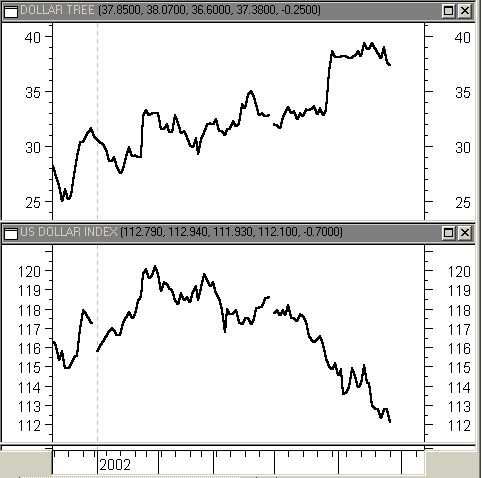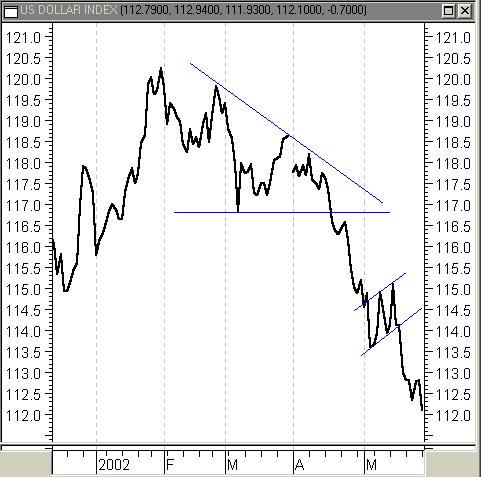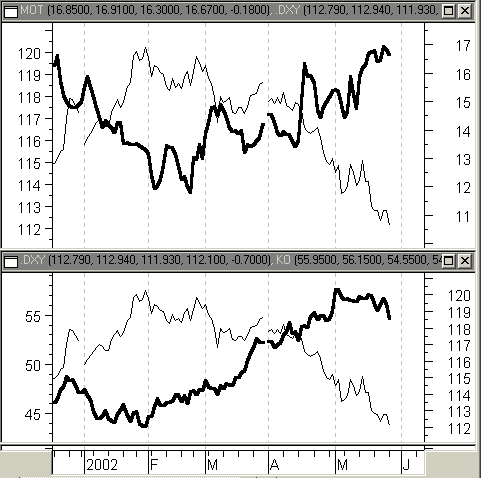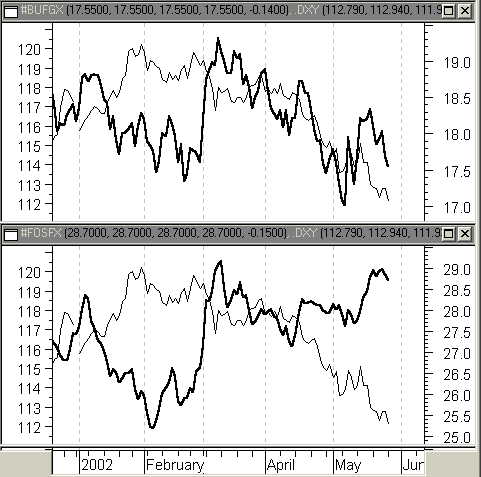
HOT TOPICS LIST
- Strategies
- Stocks
- Buy
- Investing
- Brokers
- Psychology
- Interviews
- Accumulate
- Sell
- Hold
- Spotlight
- Websites
- Candlestick Corner
- Gold & Metals
- Options Trading
LIST OF TOPICS
MARKET UPDATE
Driving Miss Dollar
06/11/02 02:38:04 PM PSTby David Penn
What does the decline in the dollar say about stocks?
| Consider the two dollars in the chart below. The first "dollar" represents a retail chain that sells a variety of products at a price of $1.00 or less. This chain — which runs stores named "Dollar Express," "Dollar Bills," "Only One Dollar," and "Only $One" — is ranked particularly high in Investor's Business Daily's stock tables, garnering particularly good marks for industry group relative strength and sales, profit margins, and return on equity. According to IBD, people are accumulating the stock as opposed to distributing it. And to top it off, this chain notched a 52-week high as recently as May 14. The second "dollar" represents the currency of the world's only superpower. This currency had a great track record of strength throughout the 1990s — in fact, there was none better — but lately the greenback, as this currency is affectionately known, has been showing signs of wear. Even though this currency is still "the world's currency," its native nation has begun to stumble under the burden of corporate debt, underwhelming profits, and the prospect of deficit spending by its government. There are those accumulating this currency as well, but they seem to be doing so more in an effort to "save" the currency than to profit from it. An IBD headline from May 23, for example, reads: "Japan Buys Up Dollars To Halt Slide, Protect Own Fragile Recovery." Oh, and on May 14 while the first "dollar" was registering a 52-week high, this second dollar rallied meekly from an almost 30-week low (Figure 1).
Figure 1: Retail chain Dollar Tree is up nearly 48% year-to-date, while the US dollar has steadily declined.
So which dollar would you invest in? Part of the point of this comparison is that, for months, pundits and government officials have been damning those market participants who, by putting their money on the line, have been selling the US dollar. Economists have been anticipating the dollar's decline for years, ever since the greenback peaked — or appeared to — late in 2000, concurrently with conclusive evidence of growing economic weakness (the Nasdaq was down 42% from its peak at the time; the Standard & Poor's 500 was down 12%). Nevertheless, much like those who called the stock market overvalued in 1998, these economists watched the US dollar rebound in late 2000 to make a higher high in mid-2001. A correction in the middle of 2001 led to still another peak before the end of the year. The dollar's doomsayers were wrong. Right?
DOOM AND THE DOLLARThat the market believes the US dollar is overvalued is obvious. Even the most casual glance at the chart of the US dollar index (Figure 2) year-to-date shows growing weakness from early spring going into summer. Those seeking chart patterns in the US dollar chart would easily discern the descending triangle in February, March, and April, as well as the bearish flag at the beginning of May that led to further declines. As more than one commentator put it, if the US dollar were a stock, it would have been worth shorting in 2002.
Figure 2: Patterns following patterns. The breakdown from a descending triangle-like formation leads to a bearish flag and further declines.
Still, many suggest that the dollar's declines are a healthy correction, or "reinflation" from previously overvalued levels. David Malpass, the perceptive chief international economist for Bear Stearns, has suggested in an article for National Review Online that "the dollar was massively strong in the late 1990s, and it is helpful to give up a little of that strength as it moves to a more stable value. This would actually be a constructive letdown in the dollar if Washington makes it clear that it does not want dollar weakness, just a stabilizing process for the dollar." But the editors of The Wall Street Journal have taken a more severe view of "dollar weakness," writing in early May:
The US had a robust currency all throughout the 1990s when times were flush. The same was true for most of the 1980s, though we recall similar moaning about the Reagan dollar. The worst recent decade for US economic policy was the 1970s, when the Nixon and Carter Treasuries decided to take NAM (National Association of Manufacturers) advice and debase the dollar. Nirvana did not arrive.
Just how "strong" a strong dollar needs to be is, of course, the heart of the problem, and the answer — Not too strong, not too weak — is accurate, but provides no practical help. In fact, to the consternation of the strong dollar advocates, those such as the National Association of Manufacturers who are actually looking forward to a reflation of the dollar would probably say that they too want a dollar that is not too strong, not too weak. But make no mistake as to what the stakes of a lower dollar are — particularly if the dollar overshoots in the "stabilizing process" Malpass wrote about. A dollar that continues to move lower will likely spark inflationary worries, sending inevitable ripples throughout the rest of the economy — with the most severe effects being felt by the financial sector, hence the aggressive protestations ("debase the dollar") by the editors of The Wall Street Journal.
STOCKS FOR DOWN DOLLARSIs a cheapening dollar an unequivocally bad event for stocks? It is hard to argue that a weak dollar helps stocks in general. As I noted in an article for Traders.com Advantage, strong currencies tend to contribute toward strong equity gains because, in part, strong currencies usually mean low inflation, which in turn means lower interest rates. And lower interest rates — outside of the context of a major deflationary market such as Japan's in the 1990s — are almost always a boost for stocks. Yet some stocks and sectors can benefit from the mildly inflationary climate that accompanies a weaker currency. In general, those companies with significant overseas sales can benefit, because a weaker US dollar means that goods manufactured in the United States — from cars to software — are cheaper abroad. This assumes willing and available buyers elsewhere — be they in Europe or the Far East (the euro, Swiss franc, yen, and Australian dollar all are up against the dollar). Look, for example, at the performance relative to the US dollar of stocks like Motorola, which has about 70% of its sales overseas, and Coca Cola, which has about 60% of its sales overseas (Figure 3).
Figure 3: Motorola and Coca Cola versus the US dollar. With strong overseas sales, some companies have avoided the perils of a weakening dollar and a weak stock market.
This is not to overstate the relationship, but those companies with significant overseas sales can get a leg up on those who are relying largely on domestic sales to generate profits when the domestic currency weakens. This provides an additional incentive to invest in such globally oriented companies. Tom Laming, Buffalo Fund's chief equity strategist, noted that buying these companies is a superior way of gaining international diversification (that is, superior — in terms of comparable returns for lower risk — to buying equities of foreign companies themselves). The current weakness in the US dollar, and the relative outperformance of stocks from companies with significant overseas sales, may point to still another advantage.
Figure 4: Buy American? Companies from other than the US are helping overseas mutual funds outperform the S&P 500 in 2002.
However, at this point, selected foreign companies appear to have the edge over US companies with significant overseas sales. Comparing the year-to-date performance of the Buffalo USA Global fund with the Fidelity Overseas fund (Figure 4), we note that the latter — which includes companies from countries such as Japan, France, and the United Kingdom — only began to outperform both the Buffalo Global fund and the S&P 500 when the dollar finally collapsed in mid-April 2002. Should the dollar's "stabilization process" continue — a process that brings the dollar down without harming the global recovery — then more gains for foreign funds and a turnaround for US companies operating globally may be at hand.
David Penn may be reached at DPenn@Traders.com.
SUGGESTED READINGLaming, Tom [2001]. "Buy American: What You Don't Know About Investing Overseas," Working Money: October.Penn, David [2002]. "Currencies And Equities," Traders.com Advantage: May. MetaStock (Equis International)
Current and past articles from Working Money, The Investors' Magazine, can be found at Working-Money.com.
|
Technical Writer for Technical Analysis of STOCKS & COMMODITIES magazine, Working-Money.com, and Traders.com Advantage.
| Title: | Traders.com Technical Writer |
| Company: | Technical Analysis, Inc. |
| Address: | 4757 California Avenue SW |
| Seattle, WA 98116 | |
| Phone # for sales: | 206 938 0570 |
| Fax: | 206 938 1307 |
| Website: | www.traders.com |
| E-mail address: | DPenn@traders.com |
Traders' Resource Links | |
| Charting the Stock Market: The Wyckoff Method -- Books | |
| Working-Money.com -- Online Trading Services | |
| Traders.com Advantage -- Online Trading Services | |
| Technical Analysis of Stocks & Commodities -- Publications and Newsletters | |
| Working Money, at Working-Money.com -- Publications and Newsletters | |
| Traders.com Advantage -- Publications and Newsletters | |
| Professional Traders Starter Kit -- Software | |
PRINT THIS ARTICLE

Request Information From Our Sponsors
- VectorVest, Inc.
- Executive Premier Workshop
- One-Day Options Course
- OptionsPro
- Retirement Income Workshop
- Sure-Fire Trading Systems (VectorVest, Inc.)
- Trading as a Business Workshop
- VectorVest 7 EOD
- VectorVest 7 RealTime/IntraDay
- VectorVest AutoTester
- VectorVest Educational Services
- VectorVest OnLine
- VectorVest Options Analyzer
- VectorVest ProGraphics v6.0
- VectorVest ProTrader 7
- VectorVest RealTime Derby Tool
- VectorVest Simulator
- VectorVest Variator
- VectorVest Watchdog
- StockCharts.com, Inc.
- Candle Patterns
- Candlestick Charting Explained
- Intermarket Technical Analysis
- John Murphy on Chart Analysis
- John Murphy's Chart Pattern Recognition
- John Murphy's Market Message
- MurphyExplainsMarketAnalysis-Intermarket Analysis
- MurphyExplainsMarketAnalysis-Visual Analysis
- StockCharts.com
- Technical Analysis of the Financial Markets
- The Visual Investor




